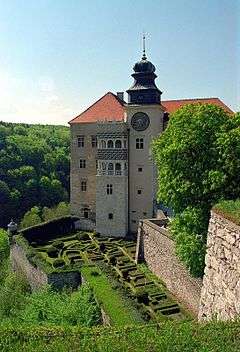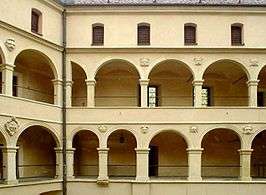Pieskowa Skała
| Pieskowa Skała Castle | |
|---|---|
 General view from the bastion. | |
| General information | |
| Architectural style | Renaissance - Mannerism[1] |
| Town or city | Sułoszowa |
| Country | Poland |
Pieskowa Skała (pronounced [pʲɛsˈkɔva skaˈwa]; Polish for Little Dog's Rock), is a limestone cliff in the valley of river Prądnik, Poland, best known for its Renaissance castle. It is located within the boundaries of the Ojców National Park, 27 km north of Kraków, near the village of Sułoszowa. The castle was first mentioned in Latin documents of Polish king Władysław I the Elbow-high (Władysław Łokietek) before 1315, as "castrum Peskenstein".
History of the castle
Pieskowa Skała castle, built by King Casimir III the Great (Kazimierz Wielki), is one of the best-known examples of a defensive Polish Renaissance architecture. It was erected in the first half of the 14th century as part of the chain of fortified castles called Orle Gniazda (Eagles Nests), along the highland plane of the Polish Jura (Polish: Jura Krakowsko-Częstochowska) extending north-west from Kraków to the city of Częstochowa.[2]
The castle was renovated and donated in 1377 by king Louis I of Hungary (Ludwik Węgierski) to Piotr Szafraniec of Łuczyce, according to the 15th century chronicler Jan Długosz.[2] The Szafraniec family gained the full ownership rights of the castle in 1422 from King Władysław Jagiełło in recognition of faithful service at the Battle of Grunwald by Piotr Szafraniec, the chamberlain of Kraków.[2]
The castle was rebuilt in 1542–1544 by Niccolò Castiglione with participation from Gabriel Słoński of Kraków.[2] The sponsor of the castle's reconstruction in the mannerist style was the Calvinist, Stanisław Szafraniec, voivode of Sandomierz.[2] At that time the original medieval tower was transformed into a scenic double loggia decorated in the sgraffito technique. Between 1557 and 1578, the trapezoid shape courtyard was surrounded at the level of two upper storeys by arcades, embellished with 21 mascarons.[2] The arcade risalit above the gate is a 17th-century addition.[2]
The last owner of the castle of Szafraniec family was Jędrzej, Stanisław's son, who died childless in 1608.[2] After his death the estate was purchased by Maciej Łubnicki and later by the Zebrzydowski family. In 1640 Michał Zebrzydowski built the bastion fortifications with baroque gate and a chapel. The castle changed hands many times over the centuries. In 1903 it was bought by the Pieskowa Skała Society led by Adolf Dygasiński and with time turned over to the Polish state and meticulously restored.[2]
Gallery of features
 Defensive façade of Pieskowa Skała
Defensive façade of Pieskowa Skała Courtyard of Pieskowa Skała Castle
Courtyard of Pieskowa Skała Castle Fortified entrance
Fortified entrance Garden
Garden
See also
- Maczuga Herkulesa, a 30 meters tall limestone Monadnock nearby
- Trail of the Eagles' Nests between Częstochowa and Kraków
- List of mannerist structures in Southern Poland
References
![]() Media related to Pieskowa Skała Castle at Wikimedia Commons
Media related to Pieskowa Skała Castle at Wikimedia Commons
Coordinates: 50°14′39″N 19°46′48″E / 50.24417°N 19.78000°E